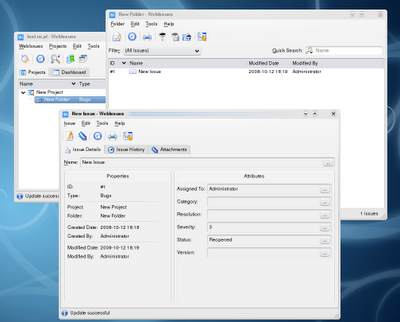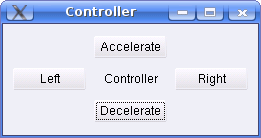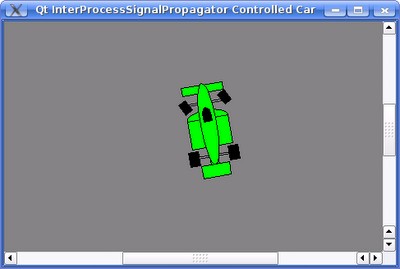>Being late seems to have become a tradition – let’s hope that we do better next time. At last the winners have been properly announced, together with their respective prizes at QtCentre.org.
Author: Johan Thelin
>IPRED
>I try not to mention these things, but this article really got my attention. Scary.
http://www.svd.se/opinion/brannpunkt/artikel_2103621.svd [Swedish only!]
>My fault
>Open source and free software can be hard some times. Time constrains and priorities sometimes collide and people get disappointed and annoied.
I’m writing to tell everyone that I’m sorry. The QtCentre programming contest has been finished since a while back. The judges have been great, and the prizes are assigned to the winners. What is missing is the “press material” from me announcing this.
The reason for not having done this on time (which was about two weeks ago) are threefold:
- Customer events at my work (due tonight, I’m speaking on Qt).
- Deadline at my customer (due on Friday, i.e. overtime every day since last Thursday)
- 7 months old daughter that I really want to see, at least on weekends as I leave for work before she gets up and see her fall asleep at night.
I know my failure to deliver means that people get upset. The judges who are done since a while back and get lots of badwill from this. The contestants not getting the final results and our sponsors, seeing a negative spin around the final stages of the contest.
As this week will continue to be hellish for me, I can only promiss to get this done during this Saturday. I hope that this will be quick enough and that you all can accept my appologies. If not, don’t nag the other guys – it is my fault.
>Qt Centre Programming Contest 2008 – Finalists
>So, the judging process has finally reached its first milestone – six finalists have been chosen. Those of you who visited FSCONS on Friday know them – to the rest of the world – the announcement is up now (yes – I know – lateish).
So, here they are, in no particular order, the finalists of this years contest:
xVideoServiceThief
“A simple, yet complete and easy to use application for downloading Flash movies from YouTube and similar sites and for converting them to other, more usable formats. It uses ffmpeg to do the conversion.”
“Allows users to write AJAX-enabled web applications in C++. It features built-in HTTP server and the application code looks almost
like Qt app.”
“An attractive alternative menu implementation for KDE 4 with clickless interface. You can drag the icon list to your desktop.”
“Qt-based client for an issue tracker written in PHP. Nice looking, complete and documented.”
“Frees the signal and slot mechanism from both the process and the actual computer. This opens a range of possibilities for Qt applications.”
“An plugin based communications application. Allows rich media sharing with a beautiful user interface.”
On behalf of everyone working hard at QtCentre I’d like to say thank you to all the contestants, all the judges, our great sponsors and everybody using the site. Thank you!
>München DevDays’08
>I’ve been wanting to blog something about DevDays, but I’m still sitting here, working. Anyway, I visited Munich and DevDays this week. A great event. Lots of people (600-ish), great talks and good beer.
DevDays seems to be the day when the QtCentre admins and moderators meet. This year Witold, Jacek, J-P, Kevin and I where there. Kevin actually visited with some silly KDE badge instead of the proper QtCentre one :-)
For me, the highlights where really Ariya’s talk on Blazing Fast Graphics (he used ray-casting – those where the days!) and Jurgen’s talk on Embedded Qt (nice to see that my customer projects fitted his template project quite nicely). Also nice where the keynotes – good to see that Nokia still wants Qt to be available everywhere.
We from QtCentre tried to fit people into our t-shirts. The snapshot below shows Justin from ICS. I also passed a t-shirt onto Benoit Schillings but I did not see him wear it. If you read this, Benoit, please mail me a photo of you wearing it or blog about it on labs.
>Fifteen Minutes of Fame
>As I’m speaking at FSCONS’08 I got interviewed by hesa.
>Model-View Seminar
>ICS Network just released a webcast featuring – tada – me, speaking about Qt’s Model-View framework. You can watch it over at the ICS Network site. Questions, comments and other discussions are help over at QtCentre’s forum thread.
>Cola!
>New Article
>I don’t know for how long it has been available on-line, but I wrote another article for Qt Quarterly. For your reading pleasure: Designing Delegates.
>Building Qt on a clean Kubuntu
>I have to admit it – I always build my own Qt. Because of customers sticking to older versions and myself wanting to have the latest, I currently have 4 flavors of Qt and 3 of QtopiaCore sitting on my laptop.
As I recently invested in a new computer I felt that I had to build Qt + Qtopia on it. The computer was installed with a clean Kubuntu from the start. The problem is that Qt requires some packages to build and finding those packages is (at least for me) a tedious iterative process (make – look what failed – apt-get install it – repeat). So, without further ado, here is a list of packages that you need to get 4.3.4 X11 to build properly:
- build-essential
- libx11-dev
- libxext-dev
So, make sure to apt-get install those before running ./configure && make && make install && echo -e "\a" . At least it keeps you from interrupting your I’m-compiling-thus-working-coffee-break. :-)
Sidenote: I guess Qt 4.4 requires some gstreamer goodies as well, I’ll tell you when I get there.






